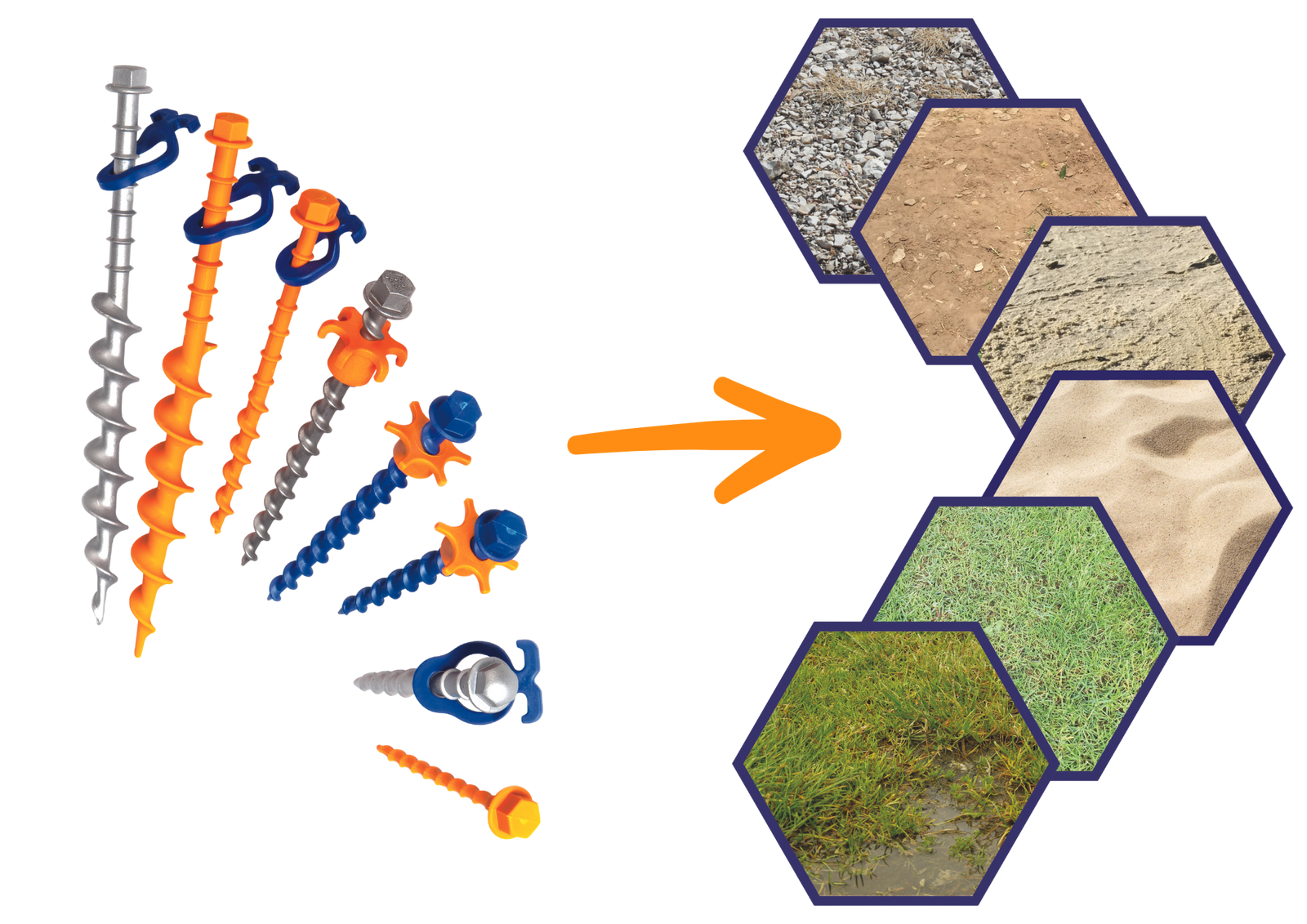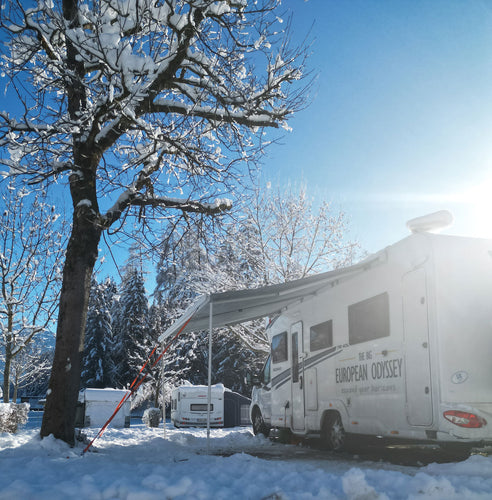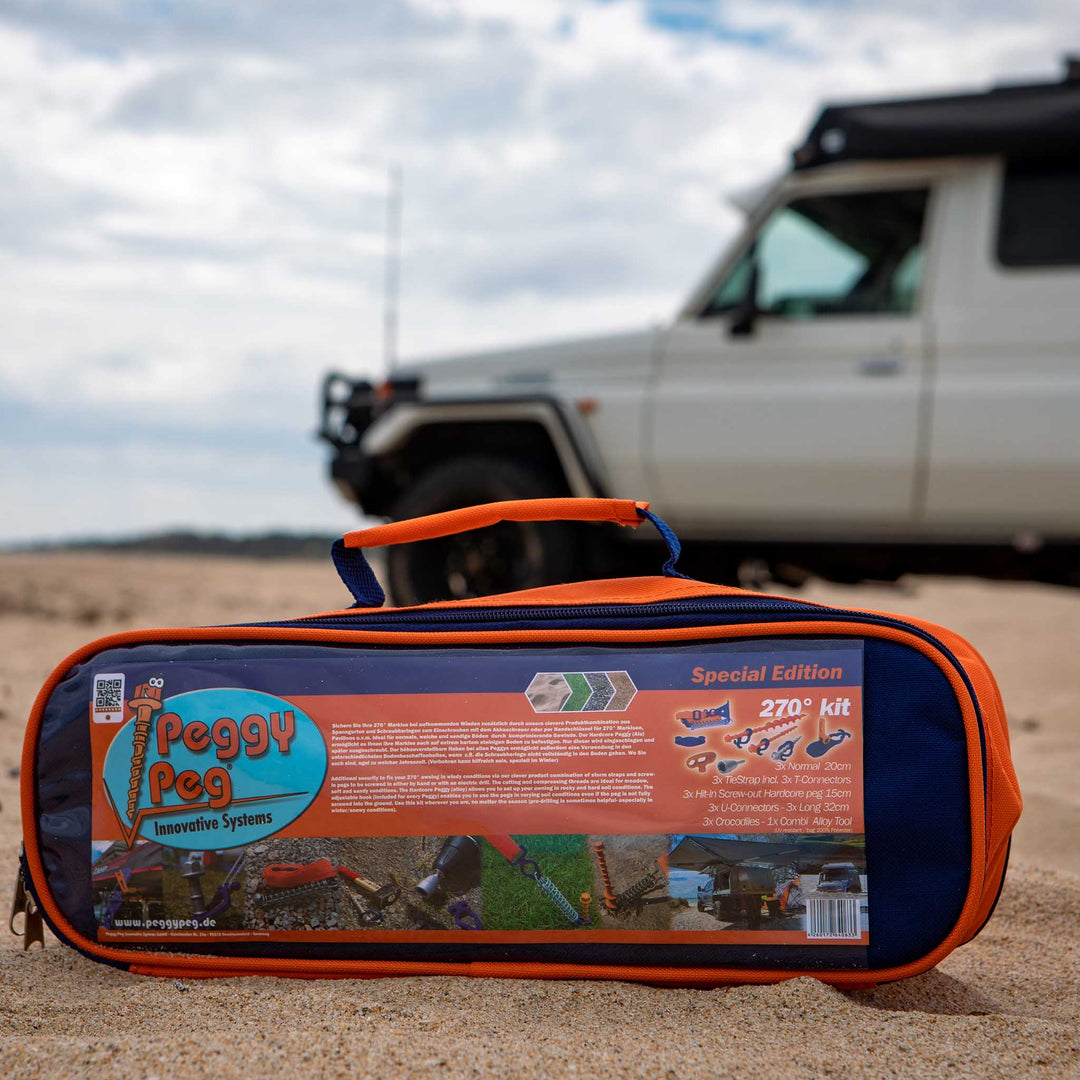Which Peggy Peg for Which Ground?

Which Peggy Peg for Which Ground?
The answer depends on the type of ground, and we have the perfect solution for each one! From soft sand to wet meadows and even rocky terrains, you always get a secure grip with Peggy Peg.
Ground Types Overview:
-
Normal – soil, grass, meadow
-
Wet – waterlogged, damp grounds
-
Compact – compact soil, compact sand
-
Loose/Soft – sand, forest soil, loose soil
-
Hard – dry, compacted grounds, solid soil
-
Extreme/Rocky – gravel, heavily compacted or rocky Ground
Tip for frozen or extremely hard ground: Pre-drill with our Peggy Peg pre-drill tool!
Peggy Peg Overview:
 |
🔹 Small (S) For: Grass, normal grounds Use: Fixing eyelets and side skirts to the ground Height Adjustment: None – screws in completely Application: Hand or cordless drill (max 5Nm) |
 |
🔹 Normal (N) For: 85% of all ground types – ideal for wet grounds All ground types from hard to slightly soft (normal, wet, soft, compact, and hard ground) Use: Universal all-rounder Height Adjustment: By hook* Application: Hand or cordless drill (max 25Nm) |
 |
🔹 Long (L) |
 |
🔹 Long Aluminium (LA) For: Soft to dense soils with stones or gravel (Sandy, stony, soft, compact & normal grounds) Use: Ultra-light while being robust Height Adjustment: By hook* Application: Hand or cordless drill (max 70Nm) Note: Soft ground allows for deep insertion, while the peg will remain further above ground on hard surfaces. |
 |
🔹 Peg&Stop Small (P&S S) For: Harder & 85% of all ground types – ideal for wet grounds, stony to compact soils (normal, wet/soft, and harder** grounds) Use: Perfect for use with our Anchor Plate 2.0. Secure hold due to counter pressure and height-adjustable system via lock nuts. Height Adjustment: By lock nut* Application: Hand or cordless drill (max 25Nm) |
 |
🔹 Peg&Stop Normal (P&S N) For: Softer & 85% of all ground types - ideal for wet soils (Compact sandy, soft & normal soils) Use: Perfect for use with our Anchor Plate 2.0. Secure hold due to counter pressure and height-adjustable system via lock nuts. Height Adjustment: By lock nut* Application: Hand or cordless drill (max 25Nm) |
 |
🔹 Peg&Stop Heavy Duty (P&S HD) For: Extremely compacted & stony grounds, and also for normal and wet soils Use: Extra strong grip even in tough conditions Height Adjustment: By lock nut* Application: Hand, cordless drill but impact driver recommended ≥ 150 Nm Special Feature: The lock nut 2.0 combines plate fixation and/or hooks for tensioning |
 |
🔹 Hardcore (HC) For: Rocky & extremely hard grounds Use: Perfect use for Anchor Plate 2.0 or guy lines/guy rope ladders Height Adjustment: By hook* Application: Hammering in with a hammer, then unscrewing Note: Replace after long periods of rain – the ground conditions change |
*Does not need to be screwed in completely thanks to our hook or counter nut system.
**Pre-drilling necessary
Summary: Which Peg for Which Ground?
| Image | Ground Type | Suitable Peggy Peg Models |
|---|---|---|
 |
Normal | Small (S), Normal (N), Long (L), Long Aluminium (LA), Peg&Stop Small (P&S S), Peg&Stop Normal (P&S N), Peg&Stop Heavy Duty (P&S HD) |
 |
Wet | Normal (N), Long (L), Long Aluminium (LA), Peg&Stop Small (P&S S), Peg&Stop Normal (P&S N), Peg&Stop Heavy Duty (P&S HD) |
 |
Loose / Soft | Long (L), Long Aluminium (LA), Peg&Stop Normal (P&S N) |
 |
Compact | Normal (N), Long (L), Long Aluminium (LA), Peg&Stop Normal (P&S N) |
 |
Hard | Normal (N), Peg&Stop Small (P&S S), Peg&Stop Heavy Duty (P&S HD), Hardcore (HC) |
 |
Extreme / Rocky | Peg&Stop Heavy Duty (P&S HD), Long Aluminium (LA), Hardcore (HC) |
| Frozen / Extremely Hard | Pre-drill for S, N, P&S S and P&S N – best choice: Peg&Stop Heavy Duty (P&S HD), Hardcore (HC) |
🔧 Application Instructions for All Pegs:
Important for our system:
Hooks:
- Always use the hooks! Only then can you take full advantage of the system.
- Make sure the hooks always face upward.
-
Position the hook as close to the ground as possible and snap it into place — this reduces the leverage from a pulling rope on the peg to zero!
[Read more about our hook system here]
Lock Nuts:
Thanks to the lock nut, Peg&Stop ground screws don’t always need to be fully screwed in all the way.
-
Always use the lock nut! Only then can you take full advantage of the system.
-
Flexible height adjustment of the screw
-
One or two turns of the counter nut are enough to securely fix tarps and anchor plates with counter pressure on the ground – without over-tightening
-
Compatible with the Fix&Go anchor plate 2.0 to ensure a stable anchoring
- Lock nut 2.0: Integrated (reusable) hook for tensioning guy lines and other straps
Tool Recommendation:
| Peg Stake | Tool | Max Torque |
|---|---|---|
| Small (S) | Hand or cordless drill | Max. 5 Nm |
| Normal (N) | Hand or cordless drill | Max. 25 Nm |
| Long (L) | Hand or cordless drill | Max. 30 Nm |
| Long Aluminium (LA) | Hand or cordless drill | Max. 70 Nm |
| Peg&Stop Small (P&S S) |
Hand or cordless drill |
Max. 25 Nm |
| Peg&Stop Normal (P&S N) |
Hand or cordless drill |
Max. 25 Nm |
| Peg&Stop Heavy Duty (P&S HD) | Impact Driver recommended | ≥ 150 Nm |
| Hardcore (HC) | Hammering, unscrewing later | Max. 70 Nm |
| Frozen/Extremely Hard | Pre-drilling recommended | – |
How to Use Our Pegs:
Learn how to choose and use our Peggy Peg screw-in pegs properly in this blog post.

Our Conclusion:
Whether sand, mud, or gravel – with Peggy Peg, you always find grip in the ground. Thanks to the innovative hook-and-lock nut system, everything is flexible, stable, and easy to handle. No more peg stress while camping!






Leave a comment